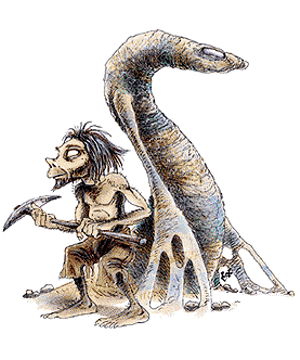

2140

| Pech | Sandling | |
|---|---|---|
| Climate/Terrain: | Any subterranean | Temperate or tropical, sandy or subterranean |
| Frequency: | Rare | Rare |
| Organization: | Clan | Solitary |
| Activity Cycle: | Darkness | Any |
| Diet: | Omnivore | Minerals |
| Intelligence: | Average to exceptional (8-16) | Non- (0) |
| Treasure: | See below | Nil |
| Alignment: | Neutral good | Neutral |
| No. Appearing: | 5-20 | 1 |
| Armor Class: | 3 | 3 |
| Movement: | 9 | 12, Br 6 |
| Hit Dice: | 4 | 4 |
| THAC0: | 17 | 17 |
| No. of Attacks: | 1 | 1 |
| Damage/Attack: | By weapon +3 | 2-16 |
| Special Attacks: | See below | Nil |
| Special Defenses: | See below | See below |
| Magic Resistance: | 25% | Nil |
| Size: | S (4’ tall) | L (10’ diameter) |
| Morale: | Average (10) | Unsteady (7) |
| XP Value: | 1,400 | 420 |
The pech are creatures of the plane of elemental Earth, though some have extensive mines in the deepest regions of the Prime Material plane. They dwell in dark places and work stone.
Pech are thin and have long arms and legs. Their broad hands and feet are excellent for bracing and employing tools to work stone. They have pale, yellowish skin and red or reddish brown hair. Their flesh is nearly as hard as granite. Their eyes are large and have no pupils. Pech have infravision to 120 feet.
Combat: The pech use picks and peat hammers (treat as war hammers) for work and armament, and are usually equipped with equal numbers of each. Pech have 18/50 Strength.
Each pech can cast four stone shape and four stone tell spells per day. Four pech can band to together to cast a wall of stone spell as a 16th-level mage. Eight together can cast a stone to flesh spell. Group spells can be cast but once per day by any group. Pech are immune to petrification.
When fighting lithic monsters such as stone golems, gargoyles, or galeb duhr, pech are quite capable of knocking them to rubble, as their knowledge of stone allows them full attack capability against such creatures, even with nonmagical weapons. Each successful strike does maximum damage.
Habitat/Society: Pech are basically good and peaceful creatures that want to be left to themselves. They hate bright light and open skies, and they are quick to ask others to douse lights. Their lairs are constructed with numerous choke points so that walls of stone can quickly stop intruders. Their lair holds 10-40 individuals, with equal numbers of females and males, and young equal to 20-50% of the females.
Ecology: The pech home plane is hostile, so many travel to the Prime Material plane to search for a better life. They have few enemies there. Pech do not save large amounts of treasure; they mine for things to trade with others for food or services. They do sometimes create simple, unobtrusive ornamental objects for everyday use. A pech lair may contain 50-100 trade gems plus 5-30 dishes and utensils worked from stone and raw metal. These items are not very valuable, averaging 150 gp each.
Sandling
These creatures are composed of silicates and originated on the elemental plane of Earth. They look like piles of sand and can vary color to blend with backgrounds. Sandlings have the same temperature as their surroundings, and are immune to sleep, charm, hold, and other mind-affecting spells or attacks. They claim territories with boundaries recognizable only by them.
Sandlings are not aggressive unless provoked, but guard their territories from intruders. If stepped on, a sandling reflexively lunges upward, trapping 1-2 man-sized opponents; opponents receive a -2 penalty to surprise rolls when attacked in this manner. If the sandling hits its targets, they are unable to attack or defend for 1d4 rounds. Sandlings also attack by slashing with an abrasive pseudopod. If at least 10 gallons of water are poured on a sandling, it is affected as if by a slow spell, and its attacks cause only half normal damage.
Sandlings have no society, and their fierce defense of their territories usually precludes cooperation, even with other members of their own race. They live on minerals, but despise organic matter, always moving several hundred yards from any place they have killed an intruder.
A sandling grows until it reaches its full size, 10 feet in diameter, then reproduces by budding. Sandling buds split from their parent when they are about 2 inches long, and an adult’s territory may swarm with thousands of these creatures. When an infant grows to at least 6 inches in diameter, it either moves off to find its own territory, or is hunted and killed by the parent. A group of immature sandlings forms a surface with myriad tiny bumps, which may trip the unwary.
Sandlings have little effect on an ecosystem, taking only a fraction of the minerals in any parcel of land. Dwarves sometimes seek them in hopes of finding a rich mineral deposit. They are said to be excellent ingredients for mortar, but they and many druids object to this treatment.

◆ 598 ◆